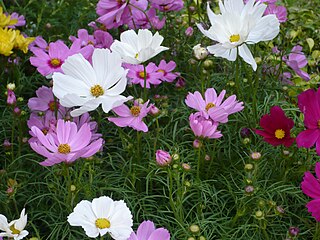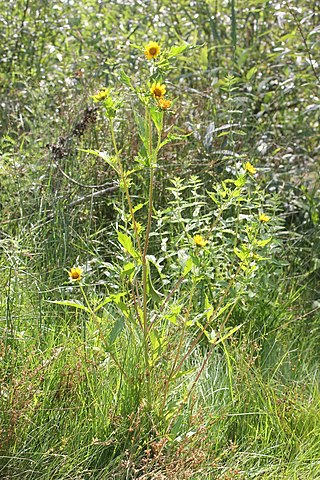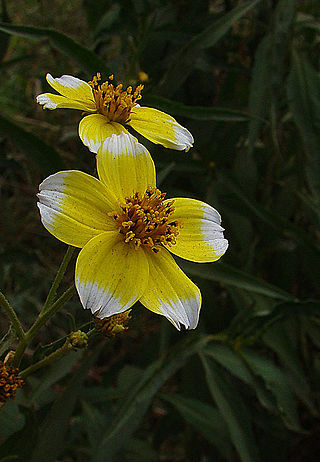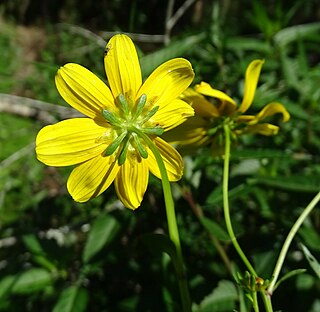
Cosmos is a genus, with the same common name of cosmos, consisting of flowering plants in the sunflower family.

Coreopsis is a genus of flowering plants in the family Asteraceae. Common names include calliopsis and tickseed, a name shared with various other plants.

Bidens tripartita is a common and widespread species of flowering plant in the sunflower family, Asteraceae, commonly known as three-lobe beggarticks, three-part beggarticks, leafy-bracted beggarticks or trifid bur-marigold. It is native to much of Eurasia, North Africa, and North America, with naturalized populations in Australia and on some Pacific Islands.

Bidens frondosa is a North American species of flowering plant in the aster family, Asteraceae. It is widespread across much of Canada, the United States, and Mexico It is known in many other parts of the world as an introduced species, including Europe, Asia, Morocco, and New Zealand. Its many common names include devil's beggarticks, devil's-pitchfork, devil's bootjack, sticktights, bur marigold, pitchfork weed, tickseed sunflower, leafy beggarticks, and common beggar-ticks.

Bidens campylotheca, the viper beggarticks, is a species of flowering plant in the family Asteraceae. It belongs to the genus Bidens, collectively called kokoʻolau or koʻokoʻolau in the Hawaiian language. It is found only in the Hawaiian Islands.

Bidens cosmoides, commonly known as the cosmosflower beggarticks, is a species of flowering plant in the sunflower family. It is endemic to mixed mesic forests at elevations of 2,000–3,000 ft (610–910 m) on the island of Kauaʻi in Hawaii. This particular member of the genus Bidens is far larger than its relatives and is pollinated by birds.
Bidens molokaiensis, the Molokaʻi beggarticks, is a species of flowering plant in the family Asteraceae. It belongs to the genus Bidens, collectively called kokoʻolau or koʻokoʻolau in the Hawaiian language. It is found only on Molokaʻi in the Hawaiian Islands.

Bidens wiebkei, the Molokaʻi koʻokoʻolau or Wiebke's beggarticks, is a species of flowering plant in the family Asteraceae. It belongs to the genus Bidens, collectively called kokoʻolau or koʻokoʻolau in the Hawaiian language. It is found only on Molokaʻi in the Hawaiian Islands. There are three occurrences of the plant remaining, for a total population of fewer than 1000.
Dendrophorbium is a genus of South American flowering plants in the family Asteraceae.

Pectis is a genus of flowering plants in the family Asteraceae described as a genus by Linnaeus in 1759.
Oxylobus is a genus of Mesoamerican flowering plants in the tribe Eupatorieae within the family Asteraceae.

Lipochaeta, common name nehe, is a genus of flowering plants in the family Asteraceae that is endemic to Hawaii.

Bidens torta, the corkscrew beggarticks, is a flowering plant species in the family Asteraceae.

Bidens micrantha is a species of flowering plant in the aster family known by the common name grassland beggarticks. It is endemic to the Hawaiian Islands, where it and other Bidens species are known as kōʻokoʻolau. It occurs in many types of habitat on Lānaʻi, Maui, and Hawaiʻi, including rocky cliffs, dry forests, mesic forests, wet forests, and high shrublands.

Bidens mauiensis, common names Maui beggarticks and ko`oko`olau, is a herb in the family Asteraceae.

Bidens amplissima, also known as the Vancouver Island beggarticks, is an annual wetland species in the family Asteraceae which displays a broad range of morphological variation and has a geographic range restricted to southwestern British Columbia and adjacent Washington State. Due to its limited global range and susceptibility to anthropogenic threats, B. amplissima is federally listed as Special Concern under Canada's Species at Risk Act and is blue-listed in British Columbia. Bidens amplissima shares a variety of morphological characteristics with two closely related species, B. cernua and B. tripartita, making identification challenging. Accurate identification also often depends on multiple morphological characters such as leaf shape, ray florets and achene shape.

Bidens aurea , the Arizona beggarticks, is a North American species of flowering plant in the family Asteraceae. It is widespread across much of Mexico and found also in Arizona and Guatemala. The species is also naturalized in parts of Europe and South America.

Bidens hyperborea is a coastal species of flowering plant in the family Asteraceae. It grows along the coasts of Hudson Bay, the Arctic Ocean, and the North Atlantic Ocean in eastern Canada and the northeastern United States.

Bidens mitis, the smallfruit beggarticks, is a North American species of flowering plant in the family Asteraceae. It is native to the eastern, southeastern, and south-central parts of the United States, from eastern Texas to southern New Jersey.
























